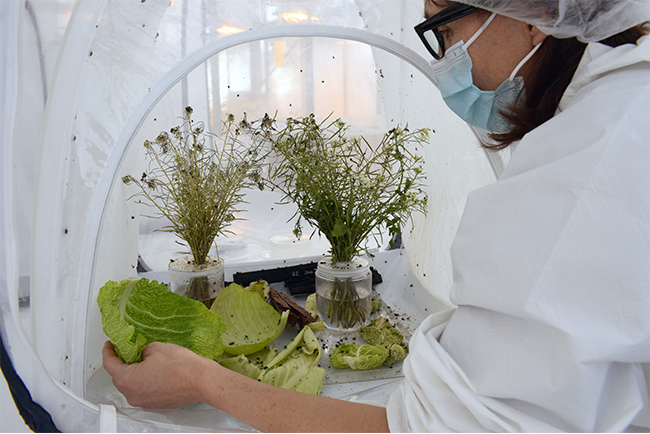Developing the Use of Hydroponic Technology to Grow Plants for Insect Rearing
As part of any classical biological control program insects must be raised, often in relatively high numbers, to facilitate all aspects of the research and eventual release (Figure 1). The insects typically are herbivorous and must be fed a variety of different plant species specific to that insect’s dietary requirements.

In many cases, plant material can be obtained from local produce markets though the produce must be organic, ensuring it is free of any insecticidal residues, which can cause serious harm and can lead to complete death of the colony. Plants can be grown outside although this is difficult during winter months, increases labor requirements, and requires an outdoor space suitable for plant growth of the specific species.
In addition, the agents under study often must be housed in a quarantine to prevent their escape. In this case, plants can be grown in secure greenhouses though this necessitates the use of soil which must be quarantined to ensure it does not contain any organism which might contaminate the secure location. In addition, space suitable to culture enough plant material must be available inside quarantine.
To help alleviate these issues associated with supplying suitable plant material, the European Biological Control Laboratory (EBCL) has been experimenting with the use of a low-cost hydroponic unit for growing the plant material. While still in the experimental stages, this approach seems promising. Hydroponics is the cultivation of plants entirely in water infused with the minerals needed for adequate plant growth. No soil is involved, though often the plants are supported by organic peat-based structures known as pods or sponges.
A hydroponic system has many advantages, including eliminating the need for soil, faster growth rate due to increased oxygen applied directly to the roots, less water use, no weeds, and higher nutrient efficiency. In addition, researchers now have a more complete control over the nutritional content of the plant material. Several economically important plants species are grown commercially with great success using a hydroponic approach including tomatoes, peppers, cucumbers, strawberries, and several varieties of lettuce.
The commercially available hydroponic unit currently being tested has successfully produced high-quality cabbage and an annual herb, White rocket; two species used for the rearing of Bagrada bug (Figures 1, 2a, b and c). The unit is composed of polyvinyl chloride (PVC) pipe containing holes along the length to house the plants and is connected to a small reservoir tank which contains the nutrient solution. Using a small pump within the reservoir tank the nutrient solution periodically flows through the pipes to nourish the plants. The unit can hold 72 plants at a time.

More testing is necessary before agreeing that such an approach can be used to either supplement plant material used for insect rearing or entirely supplant other sources of plant material.
Authors: Michael Grodowitz, Marie Roche, and Nathalie Ramualde
Contact: Michael Grodowitz
The European Biological Control Laboratory (EBCL) was established in 1991 near Montpellier, France. EBCL was created by the merger of the former European Parasite Laboratory, established in Paris in 1919, and the Biological Control of Weeds Laboratory in Rome. EBCL has a satellite laboratory in Thessaloniki, Greece. As the only USDA ARS-operated laboratory outside the United States, EBCL develops biological control technologies which can be used to suppress invading weeds and insect pests of Eurasian origin. EBCL researchers do this by searching for natural enemies (insects, mites, and pathogens) in their native habitat, determining their identity, testing their host specificity and potential impact in laboratory and field experiments, and shipping promising organisms to the U.S. for further testing as biological control agents. EBCL collaborates with scientists in many countries in Europe, Asia, and Africa to explore in regions of origin of the target weeds and insects.
